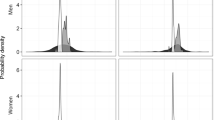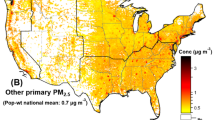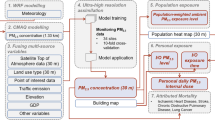Abstract
Although cohort studies of the health effects of PM2.5 have developed exposure prediction models to represent spatial variability across participant residences, few models exist for PM2.5 components. We aimed to develop a city-specific spatio-temporal prediction approach to estimate long-term average concentrations of four PM2.5 components including sulfur, silicon, and elemental and organic carbon for the Multi-Ethnic Study of Atherosclerosis cohort, and to compare predictions to those from a national spatial model. Using 2-week average measurements from a cohort-focused monitoring campaign, the spatio-temporal model employed selected geographic covariates in a universal kriging framework with the data-driven temporal trend. Relying on long-term means of daily measurements from regulatory monitoring networks, the national spatial model employed dimension-reduced predictors using universal kriging. For the spatio-temporal model, the cross-validated and temporally-adjusted R2 was relatively higher for EC and OC, and in the Los Angeles and Baltimore areas. The cross-validated R2s for both models across the six areas were reasonably high for all components except silicon. Predicted long-term concentrations at participant homes from the two models were generally highly correlated across cities but poorly correlated within cities. The spatio-temporal model may be preferred for city-specific health analyses, whereas both models could be used for multi-city studies.
This is a preview of subscription content, access via your institution
Access options
Subscribe to this journal
Receive 6 print issues and online access
$259.00 per year
only $43.17 per issue
Buy this article
- Purchase on Springer Link
- Instant access to full article PDF
Prices may be subject to local taxes which are calculated during checkout




Similar content being viewed by others
References
Laden F, Schwartz J, Speizer FE, Dockery DW. Reduction in fine particulate air pollution and mortality: extended follow-up of the Harvard Six Cities study. Am J Respir Crit Care Med 2006; 173: 667–672.
Lipsett MJ, Ostro BD, Reynolds P, Goldberg D, Hertz A, Jerrett M et al. Long-term exposure to air pollution and cardiorespiratory disease in the California teachers study cohort. Am J Respir Crit Care Med 2011; 184: 828–835.
Miller KA, Siscovick DS, Sheppard L, Shepherd K, Sullivan JH, Anderson GL et al. Long-term exposure to air pollution and incidence of cardiovascular events in women. N Engl J Med 2007; 356: 447–458.
Eeftens M, Beelen R, de Hoogh K, Bellander T, Cesaroni G, Cirach M et al. Development of land use regression models for PM(2.5), PM(2.5) absorbance, PM(10) and PM(coarse) in 20 European study areas; results of the ESCAPE project. Environ Sci Technol 2012; 46: 11195–11205.
Hoek G, Beelen R, de Hoogh K, Vienneau D, Gulliver J, Fischer P et al. A review of land-use regression models to assess spatial variation of outdoor air pollution. Atmos Environ 2008; 42: 7561–7578.
Paciorek CJ, Yanosky JD, Puett RC, Laden F, Suh HH. Practical large-scale spatio-temporal modeling of particulate matter concentrations. Ann Appl Stat 2009; 3: 370–397.
Sampson PD, Szpiro AA, Sheppard L, Lindström J, Kaufman JD. Pragmatic estimation of a spatio-temporal air quality model with irregular monitoring data. Atmos Environ 2011; 45: 6593–6606.
Szpiro AA, Sampson PD, Sheppard L, Lumley T, Adar SD, Kaufman JD. Predicting intraurban variation in air pollution concentrations with complex spatio-temporal interactions. Environmetrics 2010; 21: 606–631.
Yanosky JD, Paciorek CJ, Suh HH. Predicting chronic fine and coarse particulate exposures using spatiotemporal models for the Northeastern and Midwestern United States. Environ Health Perspect 2009; 117: 522–529.
Bell ML, Dominici F, Ebisu K, Zeger SL, Samet JM. Spatial and temporal variation in PM2.5 chemical composition in the United States for health effects studies. Environ Health Perspect 2007; 115: 989–995.
Ostro B, Feng WY, Broadwin R, Green S, Lipsett N. The effects of components of fine particulate air pollution on mortality in California: results from CALFINE. Environ Health Perspect 2007; 115: 13–19.
Peng RD, Bell ML, Geyh AS, McDermott A, Zeger SL, Samet JM et al. Emergency admissions of cardiovascular and respiratory diseases and the chemical composition of fine particle air pollution. Environ Health Perspect 2009; 117: 957–963.
Ostro B, Lipsett M, Reynolds P, Goldberg D, Hertz A, Garcia C et al. Long-term exposure to constituents of fine particulate air pollution and mortality: results from the California Teachers Study. Environ Health Perspect 2010; 118: 363–369.
Sun M, Kaufman JD, Kim SY, Larson TV, Gould TR, Polak JF et al. Particulate matter components and subclinical atherosclerosis: common approaches to estimating exposure in a Multi-Ethnic Study of Atherosclerosis cross-sectional study. Environ Health 2013; 12: 39.
de Hoogh K, Wang M, Adam M, Badaloni C, Beelen R, Birk M et al. Development of land use regression models for particle composition in twenty study areas in Europe. Environ Sci Technol 2013; 47: 5778–5786.
Vedal S, Kim SY, Miller KA, Fox JR, Bergen S, Gould T et al. NPACT epidemiologic study of components of fine particulate matter and cardiovascular disease in the MESA and WHI-OS cohorts. Research Report 178. Health Effects Institute: Boston, MA, 2013.
Bergen S, Sheppard L, Sampson PD, Kim SY, Richards M, Vedal S et al. A national prediction model for components of PM2:5 and measurement error corrected health effect inference. Environ Health Perspect 2013; 121: 1017–1025.
Cohen MA, Adar SD, Allen RW, Avol E, Curl CL, Gould T et al. Approach to estimating participant pollutant exposures in the Multi-Ethnic Study of Atherosclerosis and Air Pollution (MESA Air). Environ Sci Technol 2009; 43: 4687–4693.
Kaufman JD, Adar SD, Allen RW, Barr RG, Budoff MJ, Burke GL et al. Prospective study of particulate air pollution exposures, subclinical atherosclerosis, and clinical cardiovascular disease: the Multi-Ethnic Study of Atherosclerosis and Air Pollution (MESA Air). Am J Epidemiol 2012; 176: 825–837.
U.S. EPA Air Quality Criteria for Particulate Matter (Report No. EPA 600/P-99/002aF-bF) vol. 1. U.S. Environmental Protection Agency: Washington, DC. 2004.
Hand JL, Copeland SA, Day DE, Dillner AM, Indresand H, Malm WC et al. Spatial and seasonal patterns and temporal variability of haze and its constituents in the United States, Report V. Colorado State University, Fort Collins CO., 2011.
Kim SY, Sheppard L, Larson TV, Vedal S. Combining PM2.5 component data from multiple sources: data consistency and characteristics relevant to epidemiological analyses of predicted long-term exposures. Environ Health Perspect 2015; 123: 651–658.
Keller JP, Olives C, Kim SY, Sheppard L, Sampson PD, Szpiro AA et al. A unified spatiotemporal modeling approach for prediction of multiple air pollutants in the Multi-Ethnic Study of Atherosclerosis and Air Pollution. Environ Health Perspect 2015; 123: 301–309.
Lindstrom J, Szpiro AA, Sampson PD, Oron AP, Richards M, Larson TV et al. A flexible spatio-temporal model for air pollution with spatial and spatio-temporal covariates. Environ Ecol Stat 2013a; 21: 411–433.
Banerjee S, Carlin BP, Gelfand AE. Hierarchical Modeling and Analysis for Spatial Data. Chapman & Hall/CRC Press: Boca Raton, FL. 2004.
Tibshirani R. Regression shrinkage and selection via the Lasso. J R Stat Soc Series B 1996; 58: 267–288.
Lindström J, Szpiro AA, Sampson PD, Bergen S, Oron AP. SpatioTemporal: Spatio-Temporal Model Estimation. R package version 1.1.1. 2012.
Sampson PD, Richards M, Szpiro AA, Bergen S, Sheppard L, Larson TV et al. A regionalized national universal kriging model using partial least squares regression for estimating annual PM2.5 concentrations in epidemiology. Atmos Environ 2013; 75: 383–392.
Pope CA, III, Burnett RT, Thun MJ, Calle EE, Krewski D, Ito K et al. Lung cancer, cardiopulmonary mortality, and long-term exposure to fine particulate air pollution. JAMA 2002; 287: 1132–1141.
Kim SY, Sheppard L, Kim H. Health effects of long-term air pollution: influence of exposure prediction methods. Epidemiology 2009; 20: 442–450.
Wang M, Beelen R, Eeftens M, Meliefste K, Hoek G, Brunekreef B. Systematic evaluation of land use regression models for NO2 . Environ Sci and Technol 2012; 46: 4481–4489.
Wang M, Beelen R, Basagana X, Becker T, Cesaroni G, de Hoogh K et al. Evaluation of land use regression models for NO2 and particulate matter in 20 European study areas: the ESCAPE project. Environ Sci Technol 2013; 47: 4357–4364.
Acknowledgements
This work was primarily supported by the National Particle Component Toxicity (NPACT) initiative funded by the Health Effects Institute (HEI) (Health Effects Institute 4749-RFA05), along with the Multi-Ethnic Study of Atherosclerosis and Air Pollution by the U.S. Environmental Protection Agency (EPA) Science to Achieve Results program (STAR) research assistance agreement (RD 831697). This publication has not been formally reviewed by the EPA. The views expressed in this document are solely those of the University of Washington and the EPA does not endorse any products or commercial services mentioned in this publication. Additional support was provided by the National Institute of Environmental Health Sciences (NIEHS) (T32ES015459 and P50 ES015915), the U.S. EPA (RD 83479601 and CR-834077101-0), and the National Research Foundation of Korea (Basic Science Research Program through the National Research Foundation of Korea funded by the Ministry of Education: 2013R1A6A3A04059017).
Author information
Authors and Affiliations
Corresponding author
Ethics declarations
Competing interests
The authors declare no conflict of interest.
Additional information
Supplementary Information accompanies the paper on the Journal of Exposure Science and Environmental Epidemiology website
Supplementary information
Rights and permissions
About this article
Cite this article
Kim, SY., Sheppard, L., Bergen, S. et al. Prediction of fine particulate matter chemical components with a spatio-temporal model for the Multi-Ethnic Study of Atherosclerosis cohort. J Expo Sci Environ Epidemiol 26, 520–528 (2016). https://doi.org/10.1038/jes.2016.29
Received:
Accepted:
Published:
Issue Date:
DOI: https://doi.org/10.1038/jes.2016.29



